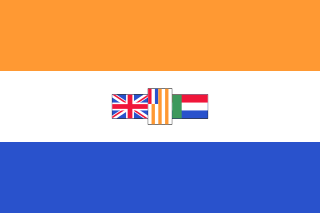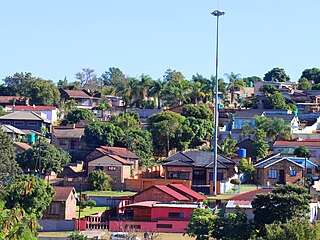
Eswatini, formally the Kingdom of Eswatini and also known by its former official name Swaziland, is a landlocked country in Southern Africa. It is bordered by Mozambique to its northeast and South Africa to its north, west, south, and southeast. At no more than 200 km (120 mi) north to south and 130 km (81 mi) east to west, Eswatini is one of the smallest countries in Africa; despite this, its climate and topography are diverse, ranging from a cool and mountainous highveld to a hot and dry lowveld.

Artifacts indicating human activity dating back to the early Stone Age have been found in the Kingdom of Eswatini. The earliest known inhabitants of the region were Khoisan hunter-gatherers. Later, the population became predominantly Nguni during and after the great Bantu migrations. People speaking languages ancestral to the current Sotho and Nguni languages began settling no later than the 11th century. The country now derives its name from a later king named Mswati II. Mswati II was the greatest of the fighting kings of Eswatini, and he greatly extended the area of the country to twice its current size. The people of Eswatini largely belong to a number of clans that can be categorized as Emakhandzambili, Bemdzabu, and Emafikamuva, depending on when and how they settled in Eswatini.

Sobhuza II, was Ngwenyama (King) of Swaziland for 82 years and 254 days, the longest verifiable reign of any monarch in recorded history.
Ngwane V was the King of Swaziland from 1895 until his death on 10 December 1899. Ngwane was born the son of Mbandzeni and his mother was Labotsibeni Mdluli. He ascended to the throne after a short regency of Queen Mother Tibati Nkambule. He was only 16 years old when he became king. His royal capital was at Zombodze while the Queen Mother's residence was at Lobamba. Ngwane became the king after the Swaziland convention of 1894. This had led to the classification of Swaziland as a protected state of the South African Republic which was then led by President Paul Kruger. During this time Swaziland had a partial Dutch administration in parallel to Ngwane's administration. The Dutch or European for European interests and Ngwane as head and authority of the Swazi nation. An annual payment was made to Ngwane and Labotsibeni while they were in office from taxes collected and from contributions from concessionaires and taxes. Ngwane's rule was short. In 1899 the Anglo-Boer war began, and brought to an end the Dutch or Boer partial administration of Swaziland and hence gave way to independence. However Mahlokohla died on 10 December of that year while dancing incwala. This was hid from the nation until the ceremony was over. Ngwane was succeeded by his four-month-old son Nkhotfotjeni and his wife Lomawa Ndwandwe. His mother Labotsibeni who had been very influential during his reign continued as queen regent until Sobhuza was crowned in 1921. Ngwane's reign gave way to a stable territory surrounded by conflicting states. Today Mahlokohla is named for one of the main streets, Mahlokohla Street in Swaziland's capital Mbabane.

KwaZulu was a semi-independent bantustan in South Africa, intended by the apartheid government as a homeland for the Zulu people. The capital was moved from Nongoma to Ulundi in 1980.

KaNgwane was a bantustan in South Africa, intended by the apartheid government to be a semi-independent homeland for the Swazi people. It was called the "Swazi Territorial Authority" from 1976 to 1977. In September 1977 it was renamed KaNgwane and received a legislative assembly. After a temporary suspension of its homeland status during 1982, the legislative assembly was restored in December 1982. KaNgwane was granted nominal self-rule in August 1984. Its capital was at Louieville. It was the least populous of the ten homelands, with an estimated 183,000 inhabitants. Unlike the other homelands in South Africa, KaNgwane did not adopt a distinctive flag of its own but flew the national flag of South Africa.
Sobhuza I (1788–1850) was king of Eswatini, from 1815 to 1850. Born around the year 1788, his father was King Ndvungunye, and his mother was Somnjalose Simelane. He was called Somhlolo, meaning "Mysterious man", upon his birth because his father, Ndvungunye, was struck by lightning. When Sobhuza was king, Lojiba Simelane, instead of his mother, Somnjalose was Queen Mother because Somnjalose was an inhlanti or support bride to Lojiba. Somhlolo is a greatly revered king of Eswatini. He had his first royal capital or kraal at Zombodze in the Shiselweni region, but moved it north to new Zombodze in central Eswatini. Swazis celebrate Somhlolo Day every September 6 as their Independence Day and the national stadium is named Somhlolo stadium. Sobhuza was succeeded by his son Mswati II and his wife Tsandzile Ndwandwe as Queen Mother after a short regency by Queen Lojiba Simelane. Sobhuza by the time of his death had conquered a country claimed to reach to modern day Barberton in the north, Carolina in the west, Pongola River in the south and Lubombo Mountains in the east.
Schoemansdal is a town in the province of Mpumalanga in South Africa. It is located 23 kilometres south of Malalane on the R570 road, just north of Jeppes Reef.
Enos John Nganani Mabuza was born at Sheba gold mine in Barberton on June 6, 1939. He attended school up to Standard eight and thereafter obtained a primary teacher's diploma in Vryheid, Natal. He then studied privately for his matric, and in 1978 received an honours degree in psychology through UNISA. Mabuza also served as chief executive councillor and chief minister of the Bantustan of KaNgwane of South Africa.
Ngwane III was King of kaNgwane from 1745 to 1780. He is considered to be the first King of modern Eswatini. For his name the people were called bakaNgwane and the country was called kaNgwane or lakaNgwane. Ngwane was the son of Dlamini III and Queen LaYaka Ndwandwe. Dlamini was succeeded by Ngwane III his son with Queen LaYaka Ndwandwe. He took over the Dlamini chieftaincy and established settlements south of the Pongola River, later moving them to the north of the river banks. This makes Ngwane and his followers the founders of modern Swaziland. Ngwane ruled his Kingdom from the south east of Swaziland in the present Shiselweni district and his headquarters were called Zombodze at the foot of the Mhlosheni hills. It was at Zombodze that the Nguni ceremony incwala was celebrated for the first time.
Dlamini is an African clan and surname, common in South Africa and Eswatini. It is the most common surname in South Africa. Most people whose surname is Dlamini are also members of the Dlamini clan.
Alexandria is a town in Bushbuckridge Local Municipality under Ehlanzeni District Municipality in the Mpumalanga province of South Africa. It got its theme of footprints on rock in the mountains of Simeleni.
Dundonald is a village in Gert Sibande District Municipality in the Mpumalanga province of South Africa. It was formerly part of the KaNgwane homeland.

Matsulu is a township in the Mbombela Local Municipality under the Ehlanzeni District Municipality in the Mpumalanga province of South Africa. It lies between Kruger National Park and the N4 national road 41 km east of Nelspruit (Mbombela) CBD, 3 km before the Kaapmuiden train station. It is also surrounded by the Nsikazi River & Crocodile River.

Matiwane, son of Masumpa, was the chief of an independent Nguni-speaking tribe, the amaNgwane, a people named after Matiwane's ancestor Ngwane. The amaNgwane lived at the headwaters of the White Umfolozi, in what is now northern KwaZulu-Natal. The cunning of Matiwane would keep the amaNgwane one step ahead of the ravages of the rising Zulu kingdom, but their actions also set the Mfecane in motion. After his tribe was ousted from their homeland by Zwide or Shaka, Matiwane and his army preyed on neighboring tribes and became vagrant marauders. Eventually he fled South into lands occupied by Xhosa States, which got his whole tribe annihilated at the Battle of Mbholompo. As a refugee Matiwane was at the mercy of the Basutos and Swazis, but eventually had to seek refuge with king Dingane, successor to Shaka. This despotic ruler put Matiwane to death shortly after Matiwane sought his protection.

111 Battalion was a motorised infantry unit of the South African Army.

Mabhuza Simeon Ginindza was a South African politician. He was born in Eerstehoek. Ginindza served both in the Apartheid homeland administration and the post-Apartheid ANC government that elected Nelson Mandela as the first black President in 1994.
Sponono Francinah Baloyi was a South African politician who represented the African National Congress (ANC) in the National Assembly from 1994 until her retirement in 2004. A nurse by profession, she was briefly the Minister of Health and Welfare in the government of the KaNgwane bantustan from 1992 to 1994.
Mangisi Cephas Zitha is a South African politician and businessman who served as the last Chief Minister of KaNgwane. He briefly represented the African National Congress (ANC) in the National Assembly after 1994 and subsequently served as South African High Commissioner to Mozambique until 1999.

Prince Johannes Mkolishi Dlamini, was the Chief of Embhuleni in Badplaas between September 1954 until his death, at age 59, in December 1988. A great-grandson of Mswati II, Mkolishi was the son of the previous Chief of Embhuleni, Prince James Maquba Dlamini, and his wife Mkhosise Madonsela.











